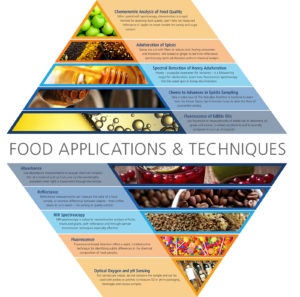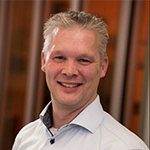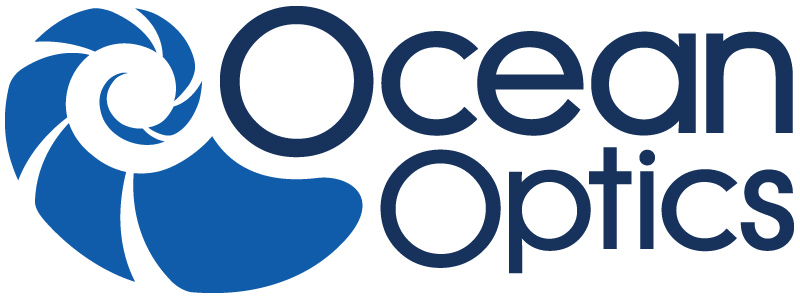The Promises and Complexities of the “Tricorder”
Today’s portable spectroscopy tools have evolved from lab instruments to field-based devices that can be easily configured for food safety testing and analysis, providing users with instant feedback and reliable results. When the appropriate approach is taken during development, custom systems for non-destructive, high-speed contaminant screening and quality sorting can be produced affordably and reproducibly. In this webinar, we will take a journey from assessing the feasibility of the application to developing a robust analytical tool for a specific solution.
Introduction
Maintaining food safety and integrity across vast and occasionally vulnerable systems is an ongoing challenge complicated by factors including pressure to increase food production to meet population growth; the threat posed by harmful microorganisms and pesticides; and the potentially dangerous consequences of food fraud.
But there’s good news: issues regarding food safety and integrity have inspired a new generation of testing and screening methods with optical sensing technologies like portable spectroscopy at their core. As this webinar explores, spectroscopy tools — and the software algorithms that analyze the spectral data those tools produce — are helping to provide faster, simpler to use and more easily deployed screening and analysis tools throughout the food chain.
Background
Many food safety testing and analysis parameters have been established in lab environments using analytical chemistry and microbiological tests. However, these tests often take considerable time and expertise to execute, and cannot be replicated easily in the field.
Those disadvantages are especially relevant in cases where adulterated food has exposed the public to the risk of injury and even death. Over the past decade, the most egregious cases of food contamination – highly toxic melamine in milk powder in China that sickened thousands of babies, and industrial oil contamination of animal feed used in the European pork market that forced a major recall – have helped spur the development of faster and more easily deployed adulterant detection technologies.
Spectroscopy Techniques
Optical sensing techniques such as portable UV, visible and NIR spectroscopy offer rapid, low-cost capabilities that complement traditional lab testing. The real-time data these spectroscopic tools capture can be combined with powerful algorithms to extract valuable insight on food samples and result in earlier assessment and identification of food contaminants.
Absorbance, reflectance and Raman spectroscopy systems from companies including Ocean Optics have proven useful for food safety testing and analysis of foods. For example, reflectance and through-sample transmission techniques in visible spectroscopy and NIR spectroscopy work well for fruit and dairy product testing; fluorescence has been used to detect mycotoxins in grains.
Also, surface enhanced Raman spectroscopy (SERS) – a highly sensitive technique useful for trace level detection of contaminants – has been applied to the detection of banned pesticides and fungicides on produce, as well as antibiotics and fungicides used in illegal fish farming. Ocean Optics offers highly selective SERS substrates with the measurement sensitivity and cost per use to make field testing feasible and affordable.
Choosing a Spectroscopy System for Food Safety Testing
Ocean Optics offers a full menu of spectrometers, multispectral imaging products, chemical sensors and accessories for food safety testing and analysis. As we’ll discuss, these tools can easily be configured for specific screening solutions, with users choosing from several options:
- Hardware options — point or imaging spectroscopy; UV, visible or NIR wavelengths
- Sampling interface — point-and-shoot, at-line or in-line
- Algorithm development – targeted or non-targeted food analysis; empirical analysis versus machine learning
Originally conceived as a research tool, portable spectroscopy has evolved beyond one-off, single-lab use to being at the centre of fully customized solutions to detect contaminants or monitor quality. Ocean Optics’ optical sensing solutions and applied spectroscopy knowledge are uniquely placed to deliver custom solutions from prototype to mass production. This is especially attractive for food producers and government regulators that until now may not have had access to simple and economical yet still robust food screening options.
Speaker

Marco Snikkers, Business Development and Strategy, Food and Agriculture, Ocean Optics
Marco Snikkers is a sales, marketing and business development professional with more than 20 years of experience in the photonics industry. He joined the applied spectral solutions provider Ocean Optics in 2005 and was commercial director for Ocean’s sales and marketing team in Europe, where he frequently collaborated with leading food producers on custom solutions for quality control, sorting and screening.
Later, Snikkers became vice president of sales and marketing for PIXELTEQ, a U.S.-based supplier of multispectral imaging and sensing products and a sister company to Ocean Optics. When PIXELTEQ assimilated into Ocean Optics in 2017, Snikkers was chosen to manage the company’s food and agriculture business development efforts. He is a frequent contributor to industry trade publications and has been a featured speaker at photonics, agriculture and food industry conferences throughout the U.S. and Europe.
Who Should Attend?
Professionals from companies or organizations involved in contract labs and corporate R&D labs, food & beverage processing, food ingredient manufacturing or supply, government agencies or labs or academic labs.
Job functions may include:
- Consultants
- Food Chemists
- Food Quality Managers (QA/QC)
- Food Safety Engineers/Managers
- Food Scientists
- Food Technicians/Technologists
- Lab Directors/Managers
- Microbiologists
- Process Engineers
Xtalks Partner
Ocean Optics
Ocean Optics combines innovative products, systems and integration development capabilities, and applied spectral knowledge to help people solve problems using spectroscopy, imaging and sensing technologies. We offer a comprehensive line of compact spectroscopy products, multispectral sensing solutions and software/algorithm development for safety, quality and authentication applications throughout the food chain.
Ocean’s technologies include chemical sensors; Raman analyzers; UV, Vis, NIR and MIR range instrumentation; sampling accessories; and analytical development software. Components and subassemblies are designed for simple integration into OEM devices and systems. We offer solutions ranging from testing and validation of lab research to the development of customized components and subassemblies as well as the design, manufacture and supply of application specific systems. Ocean Optics sensing components, subsystems and complete solutions are ideal for users ranging from food and agriculture researchers, developers and safety engineers to research scientists in academia, regulatory bodies and industry.
You Must Login To Register for this Free Webinar
Already have an account? LOGIN HERE. If you don’t have an account you need to create a free account.
Create Account

